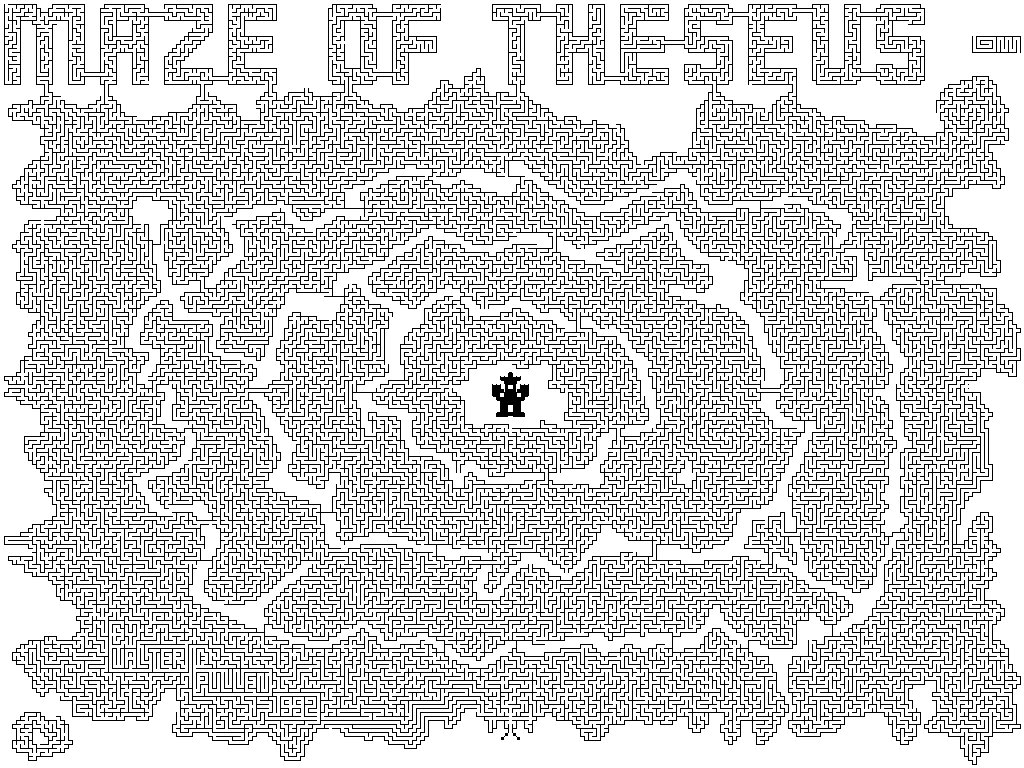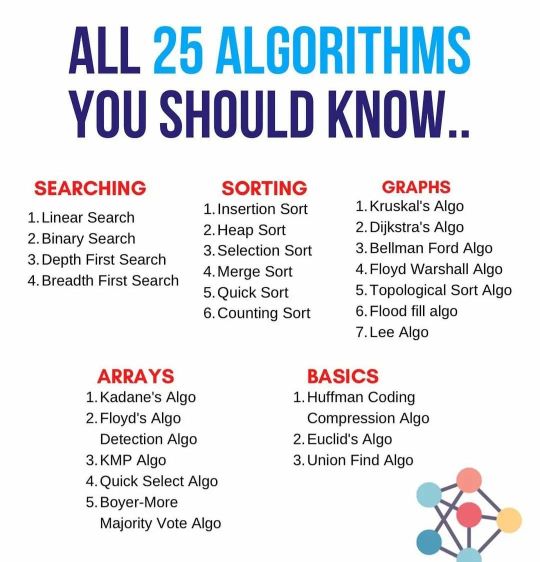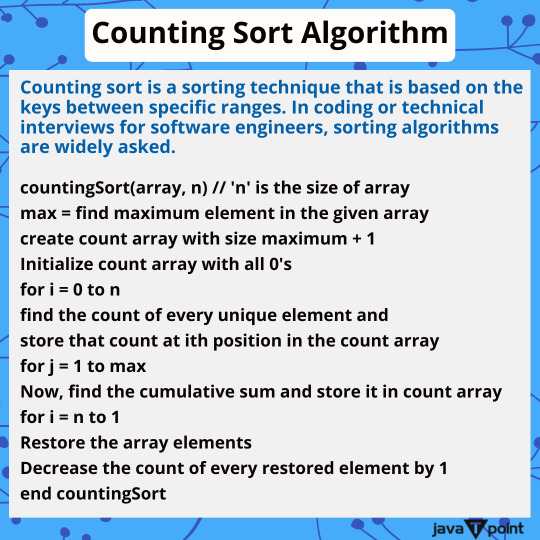#heapsort
Explore tagged Tumblr posts
Text
Exploring Quantum Leap Sort: A Conceptual Dive into Probabilistic Sorting Created Using AI
In the vast realm of sorting algorithms, where QuickSort, MergeSort, and HeapSort reign supreme, introducing a completely new approach is no small feat. Today, we’ll delve into a purely theoretical concept—Quantum Leap Sort—an imaginative algorithm created using AI that draws inspiration from quantum mechanics and probabilistic computing. While not practical for real-world use, this novel…
#AI#algorithm#amazon#chatgpt#coding#computer science#css#data-structures#DSA#engineering#google#heapsort#insertionsort#javascript#mergesort#new#programming#python#quicksort#radixsort#sorting#tech#tesla#trending#wipro
2 notes
·
View notes
Text
Algorithm is not a bad word
Named for Arabic mathematician al-Khwarizmi and partially formalized by queer mathematician Alan Turing, algorithms are simply a process for doing things, potentially with a desired result.
An early algorithm we learn in school is how to add two whole numbers together. Using pencil and paper, you can probably figure out what 420 + 69 is. In fact there are multiple ways. You could draw out 420 dots, draw another 69 dots, and count how many there are in total. Or you could lay them vertically, start at the ones column, and compute the digits of the sum.
Algorithms are not strictly related to numbers. What if you’re a teacher and you want to sort homework assignments alphabetically by the students’ names? Well you’ll probably have a process, which involves checking repeatedly if two pieces of homework are out of order (e.g. if you had homework from Bob then homework from Alice, you would swap the two since Alice is first alphabetically).
Another great non-numerical example of algorithms is solving the Rubik’s Cube and it’s larger variants. In the cube solving community, there are algorithms for specific processes, such as rotating corners cubies or flipping edge cubies. Some of these apply to the 3x3x3 cube, others can be generalized to help one solve a 69x69x69 cube.
Algorithms are also beautiful. Visualizing how the data dances around can be incredible. Check out this animation from Wikipedia showing the Heapsort algorithm in action:

This inspired the hell outta me when I first saw it in 2007. That diagram a couple seconds in, where it just sounds like it’s emitting a thunky beep at ya before suddenly just putting everything together. The way there’s sort of a pattern before it. Just that sheer magic.
You can also make art out of algorithms. From my username, one of my favorite categories is maze generation algorithms. Think Labyrinth, whose algorithm page I just linked, was an early website I found on the Internet, and I’m so happy it has survived the various eras of web evolution. The Maze of Theseus in particular was a huge inspiration for me after printing it out in 2000 on a summer road trip.

Alas Think Labyrinth is from before the days of heavy animations on the Internet, so to visualize a maze algorithm I will instead link to Mike Bostock’s article on Visualizing Algorithms. It includes many dynamic animations that are rendered in your browser, including the sorting algorithms and maze generation algorithms mentioned above, among many others.
So why the hate for algorithms?
On Tumblr in the past few days, and more generally social media in the past decade, we recently saw favoritism for sorting algorithms that allow us to view our feeds in chronological order. Many claimed they were opposed to an algorithm that decided in a corporate-specific manner what we should see first. Let me be clear: the corporate ordering of a feed is bad, but it is not bad because it’s an algorithm. It’s bad because it’s not one of the algorithms that users want for ordering their feed.
The other negative use case grew heavily in the past 15 years: algorithms that are “trained” on biased and/or unethically obtained data. We’ve seen many examples of systems that were trained on data sets of white college students such as facial recognition technology, which then later gets implemented at a large scale and fucks over people of color. The past couple years we’ve seen a rise in creating data sets based on scraping millions of artists’ works without any permission from the artists themselves*. Either of these applied to a corporate or government scale leads to active harm to populations already at risk and probably some new ones too.
Finally, we’ve seen a rise in computer automation for things that should be done by people. I can��t find the specifics, but this quote is allegedly from a 1979 IBM presentation:
A computer can never be held accountable, therefore a computer must never make a management decision.
My first thought on where this comes up is applying for jobs. Many companies will use a poorly thought out algorithm to filter through job applications, simply scanning for a couple key words they want (programmers who know Vulkan or Node.js) or more maliciously looking for words they don’t want (needing any kind of accommodation, sounding too anti-capitalist, etc). These algorithms cannot be held accountable and should not be involved in any stage of the hiring process.
Quick aside: When I was searching for the source of that quote about accountability, I typed in the first half in Google, and the autocomplete was

Fucking modern Google.
Some concluding thoughts
I like algorithms. They are a passion of mine. When people say algorithms are evil, I’m sad. When people recognize the usage of certain algorithms in certain contexts are evil, I’m more happy (yet still disturbed these things happen). I just really wanted to educate people on the usage of the word.
Also, algorithms are not about Al Gore’s dance moves. Please stop with that stupid fucking joke.
*I mentioned scraping data from millions of images without permission of the creators. My one iffy status with this is how sort of applies to the human brain doing a similar process over the span of one’s life. What is it that separates my looking through a book of Escher’s works from a computer looking at it?
Obviously many things, but I’m horrendous as philosophy and ethics, so I’m just gonna stay in my comfort zone of pure algorithms and try not to get too involved. Experts can figure out a more formal definition for what I can only describe as a gut feeling.
13 notes
·
View notes
Text
JÁ NEVÍM, JAK FUNGUJE MERGESORT, HEAPSORT, QUICKSORT, INSERTSORT, BUBBLESORT A TAK DÁL. TĚCH SORTŮ JE ASI TAK TISÍC A JÁ SI NEPAMATUJU, JAK FUNGUJE KTERÝ JEN PODLE NÁZVU. SORRY, ALE NEPAMATUJU.
UČIL JSEM SE TO V PRVÁKU A DO TÉ DOBY MI DO TÉ HLAVY VLEZLO TOLIK JINÝCH ZNALOSTÍ A TAKY KAŽDÝ NORMÁLNÍ JAZYK MÁ SORT V SOBĚ ZABUDOVANÝ, TAKŽE HO NEMUSÍM PROGRAMOVAT!
#fakt mě neprobudíte a já vám neřeknu algoritmus nějakého sortu#když bych měl naprogramovat jakýkoliv sort tak to zvládnu protože mají stejně všechny stejnou složitost#tak co na tom že to nebude heap sort ale binary sort#heap sort si strčte někam tam je potřeba ještě nějaká datová struktura vedle#bože fuj#bolest#czech#hezky česky#matfyz#student#informatika#ř
9 notes
·
View notes
Note
yer a good sort, chara. ain't done nothin wrong. (a mergesort, maybe, or a heapsort. maybe a blocksort.)
* ...
7 notes
·
View notes
Text
CS 2223. Homework 3
Q1. HeapSort Empirical Evaluation (25 pts) Algorithm 2.7 in Sedgewick, Heapsort, shows how to use a heap to sort a comparable array. The code is provided for you in algs.hw3.Heap. The first step is to construct a heap from a Comparable[] array. This takes place in the constructHeap(a) method. // construct heap from the raw array of which we know nothing. int n = a.length; for (int k = n/2; k >=…
0 notes
Text
Introsort (Introspective sort) using Function Pointers - library MetaTrader 5
Introspective Sort This is a revised version of the original Introsort library, now the Introsort() function accepts an optional function pointer to custom comparison function. Intro or Introspective sort is a hybrid sorting algorithm that provide fast performance. It is a comparison based sorting algorithm based on three phases. It uses the quicksort sort along with heapsort and insertion-sort…
0 notes
Text
CS 2500: Homework 2: Sorting
Problem 1. Workflow of Heapsort and Quicksort 25 points Demonstrate HEAP-SORT and QUICK-SORT iterations for both the following arrays: A1 = {2, 6, 4, 3, 1, 5}, and (ii) A2 = {1, 5, 2, 3, 0, 2, 2, 1, 4, 5}. Problem 2. Empirical Analysis of Heapsort and Quicksort 25 points Implement HEAP-SORT (Page 170 with supporting functions in Pages 165, 167, all in CLRS) and QUICK-SORT (Page 183, CLRS) in…
0 notes
Text
605.202.31 Data Structures LAB 4 Solved
This lab assignment requires you to compare the performance of two distinct sorting algorithms to obtain some appreciation for the parameters to be considered in selecting an appropriate sort. Write a HeapSort and a Shell Sort. They should both be recursive or both be iterative, so that the overhead of recursion will not be a factor in your comparisons. In this case, iteration is recommended.…
0 notes
Text
lecturer: "have put into the powerpoint very helpful images for walking through the example heapsort on your own"
the "helpful" images: zero annotations or colour coordination. not even arrows pointing towards the next step. just a load of "guess what i've fucking done here losers" images
0 notes
Text
Heaps and Heapsort
For this computer assignment, you are to write a C++ program to sort items in several input files, using the heapsort technique. For each input file, your program first reads the items from the input file and builds a heap structure for these items. Then, it retrieves these items from the heap structure in order and prints them out on stdout. Pointers to input files, certain constant definitions,…

View On WordPress
0 notes
Photo

Follow 4 more @elon_s.code #algorithm #algorithms Searching #linearsearch h #binarysearch #depthfirstsearch #breadthfirstsearch Sorting #insertionsort #heapsort #selectionsort #mergesort #countingsort Graphs #kruskalalgorithm #dijkstraalgorithm #bellmanfordalgorithm Arrays & basics #Java #cpp #python https://www.instagram.com/p/CnBInUiJmfq/?igshid=NGJjMDIxMWI=
#algorithm#algorithms#linearsearch#binarysearch#depthfirstsearch#breadthfirstsearch#insertionsort#heapsort#selectionsort#mergesort#countingsort#kruskalalgorithm#dijkstraalgorithm#bellmanfordalgorithm#java#cpp#python
2 notes
·
View notes
Text

Counting Sort Algorithm . . . . for more information http://bit.ly/3KiSJbT check the above link
#insertionsort#radixsort#heapsort#countingsort#datastructure#computerscience#stack#queue#lifo#fifo#computerengineering#javatpoint
0 notes
Text
Price: [price_with_discount] (as of [price_update_date] - Details) [ad_1] This book is intended for B. Tech (CS/IT), MCA and M. Tech students who want to have The basic to advanced knowledge of The design and analysis of algorithms. In This edition more algorithms are added, papers of last few years are solved in Chapters; few algorithms which were difficult to understand in previous edition are presented in easier form. Table of Content1. Introduction2. Growth of Functions3. Summations4. Recurrences5. Sets Relations and Functions6. Probability7. Heap and Heapsort 8. Quicksort9. Sorting in Linear Time10. Median and Order Statistic11. Elementary Data Structure12. Hashing13. BS Trees14. Optimal Binary search Trees15. AVL Trees and Splaying16. RB Trees17. Augmenting Data Structure18. Dynamic Programming19. Greedy Algorithms20. Amortized Analysis21. B Trees-External Searching22. Binomial Trees and Binomial Heaps23. Fibonacci Heaps24. Data Structure for Disjoint Sets25. Elementary Graph Algorithms26. Back Tracking27. Branch and Bound28. Minimum Spanning Tree29. Single-Source Shortest Paths30. All Pair Shortest Paths31. Network Flow32. Sorting Networks33. Arithmetic Circuits34. Algorithms for Parallel Computers35. Matrix Operation36. Polynomials and FFT37. Number-Theoretic Algorithms38. String Matching39. Computational Geometry40. NP-Completeness41. Non-Deterministic Algorithms42. Approximation Algorithms43. Program Publisher : Khanna Publishing; Fourth edition (1 January 2019) Language : English Paperback : 672 pages ISBN-10 : 9382609431 ISBN-13 : 978-9382609438 Item Weight : 950 g Dimensions : 20.3 x 25.4 x 4.7 cm Country of Origin : India [ad_2]
0 notes
Text
big o notation cheat sheet work TMWV?
💾 ►►► DOWNLOAD FILE 🔥🔥🔥🔥🔥 This cheat sheet for Big O Notation (a time complexity cheat sheet across data structures) will help you understand a range of complications. This Big O Notation cheat sheet (time complexity cheat sheet or data structure cheat sheet) will help you understand various complexities. Big O Complexity Chart · When your calculation is not dependent on the input size, it is a constant time complexity (O(1)). · When the input size. BIG O NOTATION CHEAT SHEET · Complexities Comparisons between typical Big Os: · What do the notations in the cheat sheet represent: · Common Data Structures. 9 Known as asymptotics, the notion of tracking algorithmic performance reveals much about a solution's effectiveness. Ironically, this area of study was primarily developed before the introduction of modern computing. Today, this provides an advantage when testing new ideas and communicating with other developers. In computer science, asymptotics is expressed in a standard format known as Big-O Notation. The performance of the algorithm is directly related to the size of the input. Examples includes standard functionality found in Arrays and basic Linked Lists. The algorithm performs on a logarithmic curve based on the size of the input. Examples includes the binary search and heapsort algorithms as well as Binary Search Trees data structure. The performance of the algorithm does not vary depending on the size of the input. Examples include operations associated with Hash Table and Stack data structures. The performance of the algorithm decreases exponentially depending on the size of the input. Ironically, many pure sorting algorithms fall into this category including the insertion, selection and bubble sort. While there are many topics, you should measure your progress by a. Start by checking off items you know and work your way through the topics as you master each item. Be sure to check out my book for more practical code-based examples in Swift. Once you think you've got things covered, review my top 20 computer science questions then register for my next free class. Data Structures act as the container for holding our data. Our data can take many forms and complete certain functions depending on the container that holds the information. The goal of an algorithm is to come up with some predefined recipe to help us solve complex problems more easily. Examples of complex commercial solutions include PageRank for Google, connecting with friends on Facebook or being able to find driving directions through Google Maps. While these sorting algorithms provide a basic overview, other important concepts one should study include traversal techniques such as depth-first and breadth-first search as well as backtracking algorithms. Thanks for reviewing my Big-O Notation cheat sheet! Top Swift Interview Questions. Top 20 Computer Science Interview Questions. Top 5 Dynamic Programming Problems. Sign In My Account. Learn Swift. Swift Algorithms Book. Online Course. Computer Science Lab. CS Interview Questions. Swift Interview Questions. Big O Notation Cheat Sheet. Dynamic Programming Problems. Free Download. Become A Member. O n - Linear Time The performance of the algorithm is directly related to the size of the input. O log n - Logarithmic TIme The algorithm performs on a logarithmic curve based on the size of the input. O 1 - Constant Time The performance of the algorithm does not vary depending on the size of the input. How to Study While there are many topics, you should measure your progress by a. Common Data Structures Data Structures act as the container for holding our data. Sorting Algorithms The goal of an algorithm is to come up with some predefined recipe to help us solve complex problems more easily.
1 note
·
View note
Text
CIS 575. Introduction to Algorithm Analysis Assignment #6
Problem (40p). Overview: We shall explore various (in-place) algorithms for sorting an array of integers. In your favorite programming language, implement: the insertion sort algorithm, and the heapsort algorithm. Your programs must also output the number of times two elements are swapped which we shall use as the measure of running time. 1. (6p) Write a program that implements the Insertion Sort…
0 notes